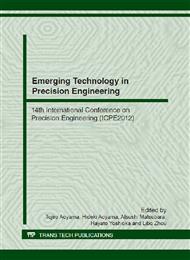p.54
p.58
p.64
p.70
p.76
p.81
p.87
p.93
p.99
Fabrication of Micropins Using Micro Turning Tools
Abstract:
The turning of straight micropins with a diameter smaller than 10 µm, which has not been reported so far, was carried out using micro turning tools made of cemented tungsten carbide. Tools of 50 µm diameter were fabricated by electrical discharge machining, which is suitable for fabricating micro cutting tools because it can deal with hard materials and carry out micromachining. A turning machine designed especially for micro turning tools was used in the experiments. A brass workpiece was turned using a tool with a length of cut of 100 µm at a feed speed of 3.0 µm/s, feed per revolution of 0.06 µm and depth of cut of 10–11 µm. As a result, a straight micropin of 7.5 µm diameter and 80 µm length was successfully turned. Furthermore, turning was also performed using a tool with a length of cut of 50 µm at a feed speed of 3.0 µm/s, feed per revolution of 0.06 µm and depth of cut of 8.5–20 µm to fabricate a straight micropin of 3 µm diameter and 30 µm length. This micropin is the pin with the smallest ever diameter fabricated by turning, to the best of our knowledge, indicating the possibility of further minimization of the machinable size in turning. Turning properties were also investigated to determine the maximum depth of cut and feed speed that can be employed without tool breakage.
Info:
Periodical:
Pages:
76-80
Citation:
Online since:
November 2012
Authors:
Price:
Сopyright:
© 2012 Trans Tech Publications Ltd. All Rights Reserved
Share:
Citation:


